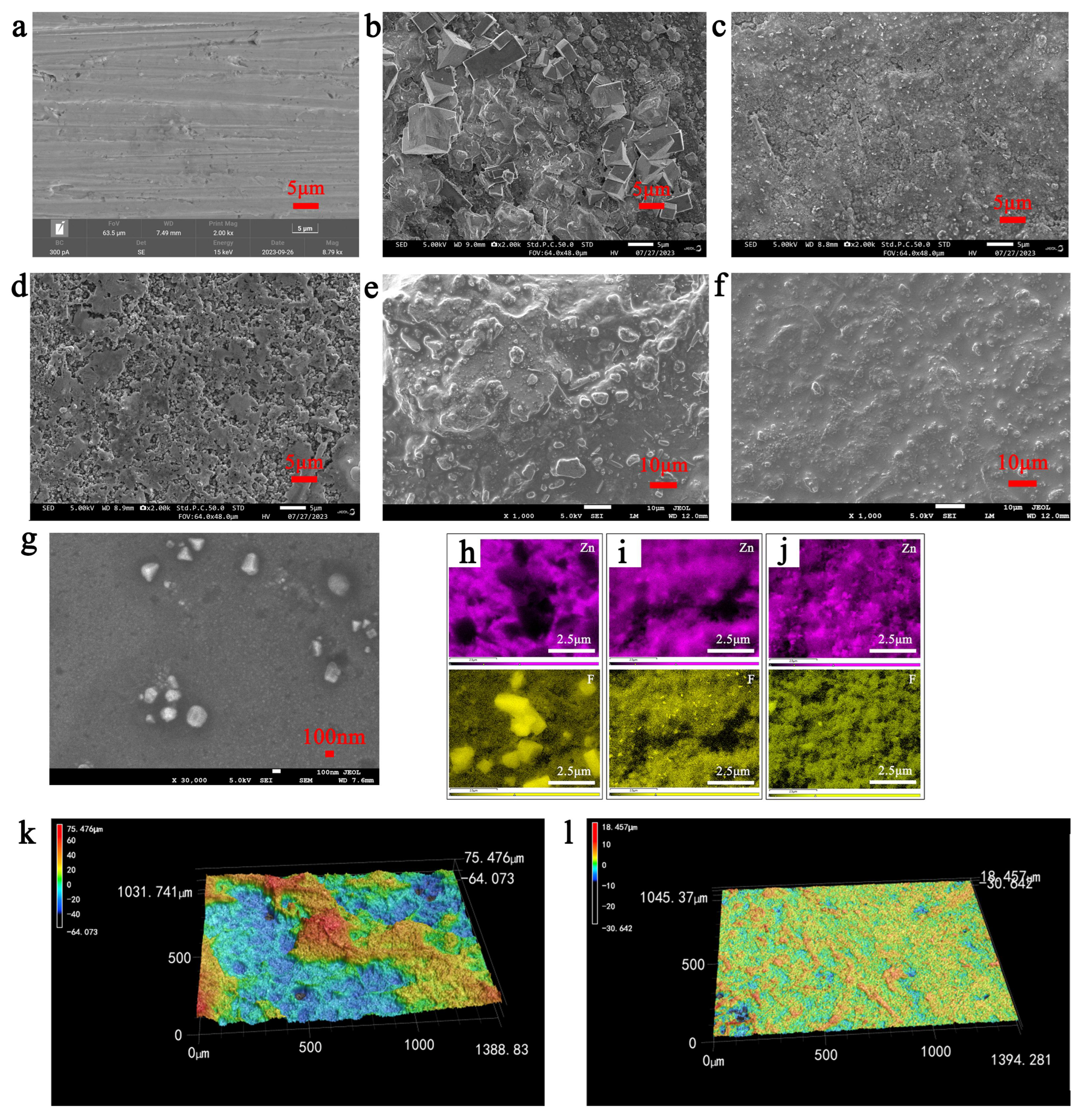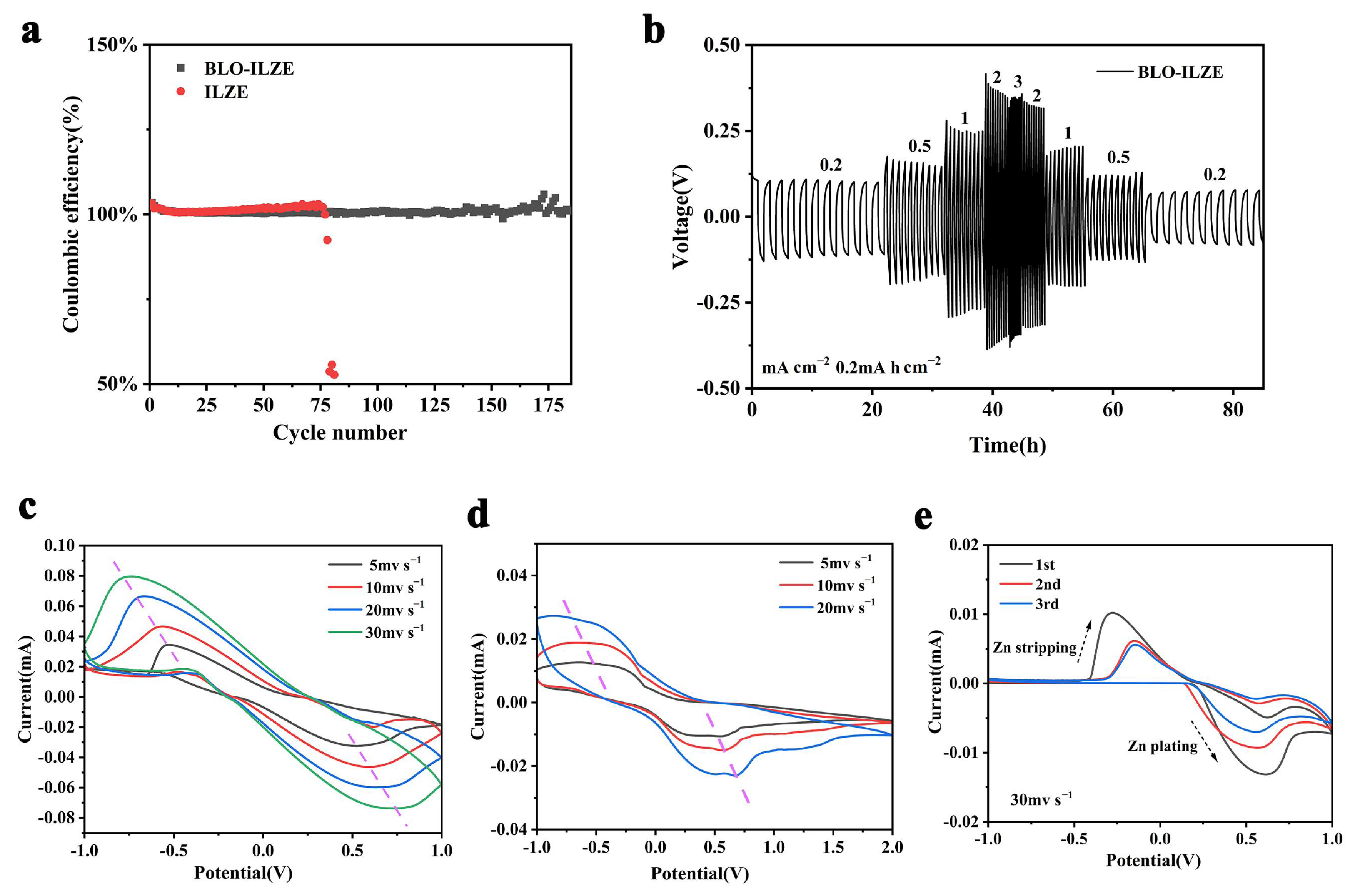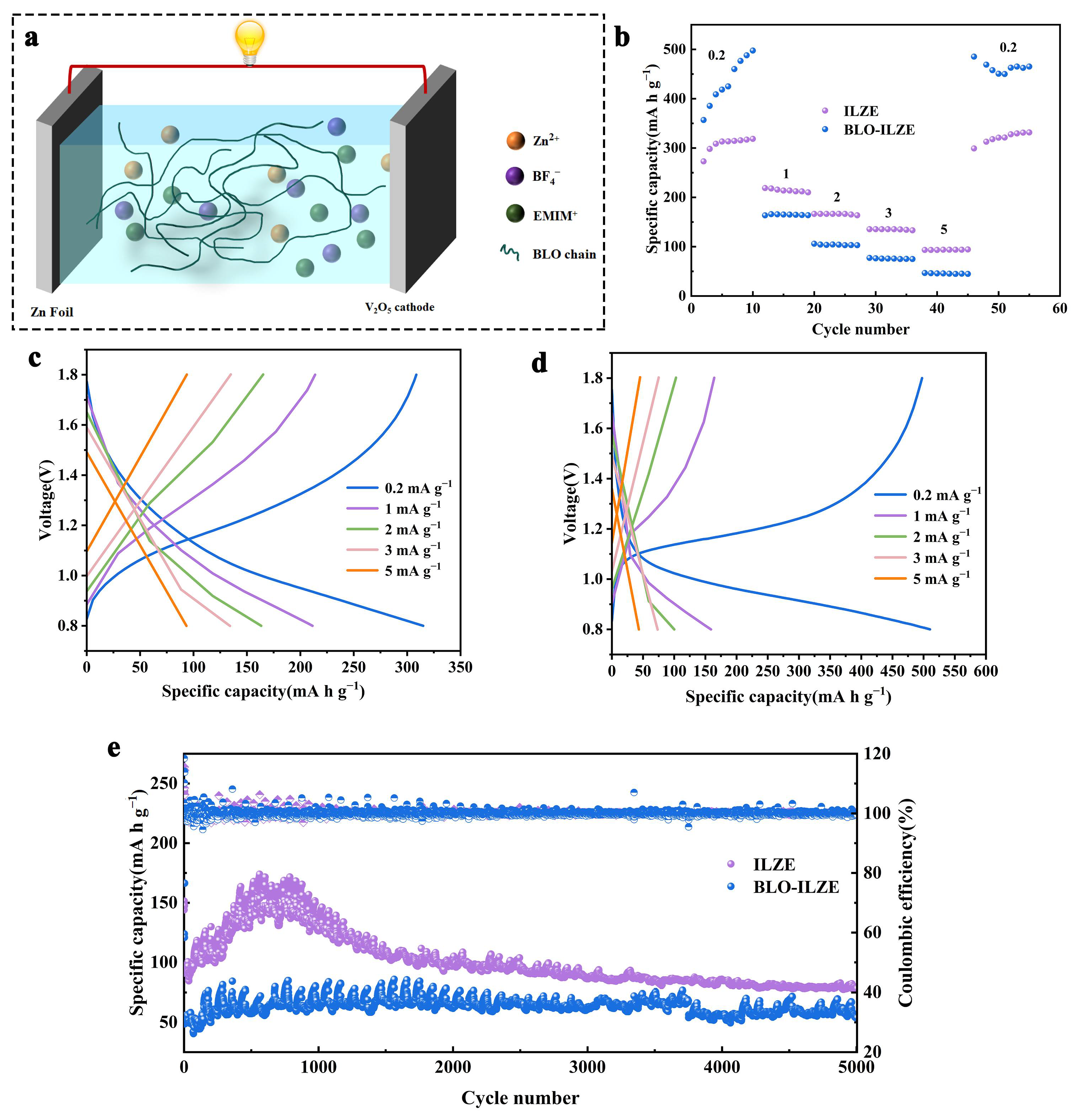An Ionic Liquid Supramolecular Gel Electrolyte with Unique Wide Operating Temperature Range Properties for Zinc-Ion Batteries
Abstract
:1. Introduction
2. Experimental Section
2.1. Materials
2.2. Synthesis of BLO Gelator
2.3. Preparation of BLO-ILZE Electrolyte
2.4. Characterization
2.5. Binding Energy Calculations
2.6. Electrochemical Measurements
3. Results and Discussion
3.1. Preparation of BLO-ILZE Electrolyte
3.2. The Conductivity of the Electrolytes
3.3. Electrochemical Performance of Symmetric Zn/Zn Cells
3.4. Electrochemical Performance of Zn/Cu Asymmetric Cells
3.5. Electrochemical Performance of Full Cells
4. Conclusions
Supplementary Materials
Author Contributions
Funding
Institutional Review Board Statement
Data Availability Statement
Conflicts of Interest
References
- Liang, L.; Sun, X.; Zhang, J.; Sun, J.; Hou, L.; Liu, Y.; Yuan, C. Sur-/Interfacial Regulation in All-Solid-State Rechargeable Li-Ion Batteries Based on Inorganic Solid-State Electrolytes: Advances and Perspectives. Mater. Horiz. 2019, 6, 871–910. [Google Scholar] [CrossRef]
- Yuan, L.; Hao, J.; Kao, C.-C.; Wu, C.; Liu, H.-K.; Dou, S.-X.; Qiao, S.-Z. Regulation Methods for the Zn/Electrolyte Interphase and the Effectiveness Evaluation in Aqueous Zn-Ion Batteries. Energy Environ. Sci. 2021, 14, 5669–5689. [Google Scholar] [CrossRef]
- Xiao, X.; Zheng, Z.; Zhong, X.; Gao, R.; Piao, Z.; Jiao, M.; Zhou, G. Rational Design of Flexible Zn-Based Batteries for Wearable Electronic Devices. ACS Nano 2023, 17, 1764–1802. [Google Scholar] [CrossRef]
- Cui, M.; Fei, J.; Mo, F.; Lei, H.; Huang, Y. Ultra-High-Capacity and Dendrite-Free Zinc–Sulfur Conversion Batteries Based on a Low-Cost Deep Eutectic Solvent. ACS Appl. Mater. Interfaces 2021, 13, 54981–54989. [Google Scholar] [CrossRef]
- Hong, L.; Wu, X.; Ma, C.; Huang, W.; Zhou, Y.; Wang, K.-X.; Chen, J.-S. Boosting the Zn-Ion Transfer Kinetics to Stabilize the Zn Metal Interface for High-Performance Rechargeable Zn-Ion Batteries. J. Mater. Chem. A 2021, 9, 16814–16823. [Google Scholar] [CrossRef]
- Lv, T.-T.; Liu, Y.-Y.; Wang, H.; Yang, S.-Y.; Liu, C.-S.; Pang, H. Crystal Water Enlarging the Interlayer Spacing of Ultrathin V2O5·4VO2·2.72H2O Nanobelts for High-Performance Aqueous Zinc-Ion Battery. Chem. Eng. J. 2021, 411, 128533. [Google Scholar] [CrossRef]
- Xie, X.; Liang, S.; Gao, J.; Guo, S.; Guo, J.; Wang, C.; Xu, G.; Wu, X.; Chen, G.; Zhou, J. Manipulating the Ion-Transfer Kinetics and Interface Stability for High-Performance Zinc Metal Anodes. Energy Environ. Sci. 2020, 13, 503–510. [Google Scholar] [CrossRef]
- Li, C.; Zhang, C. A-Optimal Designs for Quadratic Mixture Canonical Polynomials with Spline. J. Stat. Plan. Interfaces 2020, 207, 1–9. [Google Scholar] [CrossRef]
- Zhang, Y.; Liu, Y.; Liu, Z.; Wu, X.; Wen, Y.; Chen, H.; Ni, X.; Liu, G.; Huang, J.; Peng, S. MnO2 Cathode Materials with the Improved Stability via Nitrogen Doping for Aqueous Zinc-Ion Batteries. J. Energy Chem. 2022, 64, 23–32. [Google Scholar] [CrossRef]
- Liu, C.; Neale, Z.; Zheng, J.; Jia, X.; Huang, J.; Yan, M.; Tian, M.; Wang, M.; Yang, J.; Cao, G. Expanded Hydrated Vanadate for High-Performance Aqueous Zinc-Ion Batteries. Energy Environ. Sci. 2019, 12, 2273–2285. [Google Scholar] [CrossRef]
- Chen, Q.; Luo, Z.; Zhao, X. K-Ion Intercalated V6O13 with Advanced High-Rate Long-Cycle Performance as Cathode for Zn-Ion Batteries. J. Mater. Chem. C 2022, 10, 590–597. [Google Scholar] [CrossRef]
- Zhou, L.-F.; Du, T.; Li, J.-Y.; Wang, Y.-S.; Gong, H.; Yang, Q.-R.; Chen, H.; Luo, W.-B.; Wang, J.-Z. A Strategy for Anode Modification for Future Zinc-Based Battery Application. Mater. Horiz. 2022, 9, 2722–2751. [Google Scholar] [CrossRef]
- Manickam, M.; Singh, P.; Issa, T.B.; Thurgate, S.; Prince, K. Electrochemical Behavior of LiFePO4 in Aqueous Lithium Hydroxide Electrolyte. Key Eng. Mater. 2006, 320, 271–274. [Google Scholar] [CrossRef]
- Manickam, M.; Singh, P.; Thurgate, S.; Prince, K. Redox Behavior and Surface Characterization of LiFePO4 in Lithium Hydroxide Electrolyte. J. Power Sources 2006, 158, 646–649. [Google Scholar] [CrossRef]
- Li, Z.; Xu, Y.; Wu, L.; An, Y.; Sun, Y.; Meng, T.; Dou, H.; Xuan, Y.; Zhang, X. Zinc Ion Thermal Charging Cell for Low-Grade Heat Conversion and Energy Storage. Nat. Commun. 2022, 13, 132. [Google Scholar] [CrossRef]
- Yu, M.; Chandrasekhar, N.; Raghupathy, R.K.M.; Ly, K.H.; Zhang, H.; Dmitrieva, E.; Liang, C.; Lu, X.; Kühne, T.D.; Mirhosseini, H.; et al. A High-Rate Two-Dimensional Polyarylimide Covalent Organic Framework Anode for Aqueous Zn-Ion Energy Storage Devices. J. Am. Chem. Soc. 2020, 142, 19570–19578. [Google Scholar] [CrossRef]
- Cao, L.; Li, D.; Soto, F.A.; Ponce, V.; Zhang, B.; Ma, L.; Deng, T.; Seminario, J.M.; Hu, E.; Yang, X.; et al. Highly Reversible Aqueous Zinc Batteries Enabled by Zincophilic–Zincophobic Interfacial Layers and Interrupted Hydrogen-Bond Electrolytes. Angew. Chem. Int. Ed. 2021, 60, 18845–18851. [Google Scholar] [CrossRef]
- Guo, W.; Zhang, Y.; Tong, X.; Wang, X.; Zhang, L.; Xia, X.; Tu, J. Multifunctional Tin Layer Enabled Long-Life and Stable Anode for Aqueous Zinc-Ion Batteries. Mater. Today Energy 2021, 20, 100675. [Google Scholar] [CrossRef]
- Zhang, Y.; Wu, D.; Huang, F.; Cai, Y.; Li, Y.; Ke, H.; Lv, P.; Wei, Q. “Water-in-Salt” Nonalkaline Gel Polymer Electrolytes Enable Flexible Zinc-Air Batteries with Ultra-Long Operating Time. Adv. Funct. Mater. 2022, 32, 2203204. [Google Scholar] [CrossRef]
- Elia, G.A.; Ulissi, U.; Mueller, F.; Reiter, J.; Tsiouvaras, N.; Sun, Y.; Scrosati, B.; Passerini, S.; Hassoun, J. A Long-Life Lithium Ion Battery with Enhanced Electrode/Electrolyte Interface by Using an Ionic Liquid Solution. Chem. A Eur. J. 2016, 22, 6808–6814. [Google Scholar] [CrossRef]
- Wang, H.; Yang, Y.; Guo, L. Nature-Inspired Electrochemical Energy-Storage Materials and Devices. Adv. Energy Mater. 2017, 7, 1601709. [Google Scholar] [CrossRef]
- MacFarlane, D.R.; Tachikawa, N.; Forsyth, M.; Pringle, J.M.; Howlett, P.C.; Elliott, G.D.; Davis, J.H.; Watanabe, M.; Simon, P.; Angell, C.A. Energy Applications of Ionic Liquids. Energy Environ. Sci. 2013, 7, 232–250. [Google Scholar] [CrossRef]
- Liu, Z.; Pulletikurthi, G.; Endres, F. A Prussian Blue/Zinc Secondary Battery with a Bio-Ionic Liquid–Water Mixture as Electrolyte. ACS Appl. Mater. Interfaces 2016, 8, 12158–12164. [Google Scholar] [CrossRef]
- Brogan, A.P.S.; Clarke, C.J.; Charalambidou, A.; Loynachan, C.N.; Norman, S.E.; Doutch, J.; Hallett, J.P. Expanding the Design Space of Gel Materials through Ionic Liquid Mediated Mechanical and Structural Tuneability. Mater. Horiz. 2020, 7, 820–826. [Google Scholar] [CrossRef]
- Jian, Y.; Handschuh-Wang, S.; Zhang, J.; Lu, W.; Zhou, X.; Chen, T. Biomimetic Anti-Freezing Polymeric Hydrogels: Keeping Soft-Wet Materials Active in Cold Environments. Mater. Horiz. 2021, 8, 351–369. [Google Scholar] [CrossRef]
- Mahdavi, H.; Smith, S.J.D.; Mulet, X.; Hill, M.R. Practical Considerations in the Design and Use of Porous Liquids. Mater. Horiz. 2022, 9, 1577–1601. [Google Scholar] [CrossRef]
- Nguyen Thanh Tran, T.; Zhao, M.; Geng, S.; Ivey, D.G. Ethylene Glycol as an Antifreeze Additive and Corrosion Inhibitor for Aqueous Zinc-Ion Batteries. Batter. Supercaps 2022, 5, e202100420. [Google Scholar] [CrossRef]
- Banerjee, S.; Das, R.K.; Maitra, U. Supramolecular Gels ‘in Action’. J. Mater. Chem. 2009, 19, 6649. [Google Scholar] [CrossRef]
- Li, G.; Zhang, X.; Sang, M.; Wang, X.; Zuo, D.; Xu, J.; Zhang, H. A Supramolecular Hydrogel Electrolyte for High-Performance Supercapacitors. J. Energy Storage 2021, 33, 101931. [Google Scholar] [CrossRef]
- Makarević, J.; Jokić, M.; Raza, Z.; Štefanić, Z.; Kojić-Prodić, B.; Žinić, M. Chiral Bis(Amino Alcohol)Oxalamide Gelators–Gelation Properties and Supramolecular Organization: Racemate versus Pure Enantiomer Gelation. Chem.-Eur. J. 2003, 9, 5567–5580. [Google Scholar] [CrossRef]
- Zhao, K.; Fan, G.; Liu, J.; Liu, F.; Li, J.; Zhou, X.; Ni, Y.; Yu, M.; Zhang, Y.-M.; Su, H.; et al. Boosting the Kinetics and Stability of Zn Anodes in Aqueous Electrolytes with Supramolecular Cyclodextrin Additives. J. Am. Chem. Soc. 2022, 144, 11129–11137. [Google Scholar] [CrossRef]
- Frkanec, L.; Žinić, M. Chiral Bis(Amino Acid)- and Bis(Amino Alcohol)-Oxalamide Gelators. Gelation Properties, Self-Assembly Motifs and Chirality Effects. Chem. Commun. 2010, 46, 522–537. [Google Scholar] [CrossRef]
- Tian, P.; Zhong, X.; Gu, C.; Wang, Z.; Shi, F. SiO2-Alginate-Based Gel Polymer Electrolytes for Zinc-Ion Batteries. Batteries 2022, 8, 175. [Google Scholar] [CrossRef]
- Ma, L.; Chen, S.; Li, N.; Liu, Z.; Tang, Z.; Zapien, J.A.; Chen, S.; Fan, J.; Zhi, C. Hydrogen-Free and Dendrite-Free All-Solid-State Zn-Ion Batteries. Adv. Mater. 2020, 32, e1908121. [Google Scholar] [CrossRef]
- Zhang, H.; Liu, X.; Li, H.; Qin, B.; Passerini, S. High-Voltage Operation of a V 2 O 5 Cathode in a Concentrated Gel Polymer Electrolyte for High-Energy Aqueous Zinc Batteries. ACS Appl. Mater. Interfaces 2020, 12, 15305–15312. [Google Scholar] [CrossRef]
- Dong, H.; Li, J.; Guo, J.; Lai, F.; Zhao, F.; Jiao, Y.; Brett, D.J.L.; Liu, T.; He, G.; Parkin, I.P. Insights on Flexible Zinc-Ion Batteries from Lab Research to Commercialization. Adv. Mater. 2021, 33, 2007548. [Google Scholar] [CrossRef]
- Wang, L.; Huang, K.-W.; Chen, J.; Zheng, J. Ultralong Cycle Stability of Aqueous Zinc-Ion Batteries with Zinc Vanadium Oxide Cathodes. Sci. Adv. 2019, 5, eaax4279. [Google Scholar] [CrossRef]
- Ni, Q.; Kim, B.; Wu, C.; Kang, K. Non-Electrode Components for Rechargeable Aqueous Zinc Batteries: Electrolytes, Solid-Electrolyte-Interphase, Current Collectors, Binders, and Separators. Adv. Mater. 2022, 34, 2108206. [Google Scholar] [CrossRef]
- Yang, Y.; Huang, C.; Li, H.; Teng, Z.; Zhang, H.; Wei, X.; Zhang, H.; Wu, L.; Zhang, C.; Chen, W. Study of a Novel Supramolecular Hydrogel Electrolyte for Aqueous Zinc Ion Batteries. J. Mater. Chem. C 2023, 11, 9559–9569. [Google Scholar] [CrossRef]
- Cao, F.; Wu, B.; Li, T.; Sun, S.; Jiao, Y.; Wu, P. Mechanoadaptive Morphing Gel Electrolyte Enables Flexible and Fast-Charging Zn-Ion Batteries with Outstanding Dendrite Suppression Performance. Nano Res. 2022, 15, 2030–2039. [Google Scholar] [CrossRef]
- Liu, S.; Lei, T.; Song, Q.; Zhu, J.; Zhu, C. High Energy, Long Cycle, and Superior Low Temperature Performance Aqueous Na−Zn Hybrid Batteries Enabled by a LowCost and Protective Interphase Film-Forming Electrolyte. ACS Appl. Mater. Interfaces 2022, 14, 11425–11434. [Google Scholar] [CrossRef]
- Qin, R.; Wang, Y.; Zhang, M.; Wang, Y.; Ding, S.; Song, A.; Yi, H.; Yang, L.; Song, Y.; Cui, Y.; et al. Tuning Zn2+ Coordination Environment to Suppress Dendrite Formation for High-Performance Zn-Ion Batteries. Nano Energy 2021, 80, 105478. [Google Scholar] [CrossRef]
- Zhang, L.; Wang, G.; Feng, J.; Ma, Q.; Liu, Z.; Yan, X. Designing AZn(BF 4)2-Based Ionic Liquid Electrolyte to Realize Superior Energy Density InaCarbon-Based Zinc-Ion Hybrid Capacitor. ChemElectroChem 2021, 8, 1289–1297. [Google Scholar] [CrossRef]
- Eskusson, J.; Thomberg, T.; Lust, E.; Jänes, A. Electrochemical Characteristics of Zn-Ion Hybrid Supercapacitors Based on Aqueous Solution of Different Electrolytes. J. Electrochem. Soc. 2022, 169, 020512. [Google Scholar] [CrossRef]
- Han, D.; Cui, C.; Zhang, K.; Wang, Z.; Gao, J.; Guo, Y.; Zhang, Z.; Wu, S.; Yin, L.; Weng, Z.; et al. A Non-Flammable Hydrous Organic Electrolyte for Sustainable Zinc Batteries. Nat. Sustain. 2021, 5, 205–213. [Google Scholar] [CrossRef]
- Ding, F.; Xu, W.; Graff, G.L.; Zhang, J.; Sushko, M.L.; Chen, X.; Shao, Y.; Engelhard, M.H.; Nie, Z.; Xiao, J.; et al. Dendrite-Free Lithium Deposition via Self-Healing Electrostatic Shield Mechanism. J. Am. Chem. Soc. 2013, 135, 4450–4456. [Google Scholar] [CrossRef] [PubMed]
- Li, X.; Xiang, J.; Liu, H.; Wang, P.; Chen, C.; Gao, T.; Guo, Y.; Xiao, D.; Jin, Z. Molecularly Modulating Solvation Structure and Electrode Interface Enables Dendrite-Free Zinc-Ion Batteries. J. Colloid Interface Sci. 2024, 654, 476–485. [Google Scholar] [CrossRef]
- Wang, J.; Tian, J.; Liu, G.; Shen, Z.; Wen, R. In Situ Insight into the Interfacial Dynamics in “Water-in-Salt” Electrolyte-Based Aqueous Zinc Batteries. Small Methods 2023, 7, e2300392. [Google Scholar] [CrossRef] [PubMed]
- Cui, Y.; He, Y.; Yu, W.; Shang, W.; Yu, J.; Tan, P. Tailoring the Electrochemical Deposition of Zn by Tuning the Viscosity of the Liquid Electrolyte. ACS Appl. Mater. Interfaces 2023, 15, 3028–3036. [Google Scholar] [CrossRef] [PubMed]
- Portada, T.; Molčanov, K.; Šijaković Vujičić, N.; Žinić, M. Biphenyl Bis(Amino Alcohol) Oxalamide Gelators: Complex Gelation Involving Coupled Equilibria, Central-to-Axial Chirality Transfer, Dia stereoisomer Interconversion, and Self-Sorting. Eur. J. Org. Chem. 2016, 2016, 1205–1214. [Google Scholar] [CrossRef]
- Yu, L.; Huang, J.; Wang, S.; Qi, L.; Wang, S.; Chen, C. Ionic Liquid “Water Pocket” for Stable and Environment-Adaptable Aqueous Zinc Metal Batteries. Adv. Mater. 2023, 35, e2210789. [Google Scholar] [CrossRef] [PubMed]
- Tang, Y.; Liu, C.; Zhu, H.; Xie, X.; Gao, J.; Deng, C.; Han, M.; Liang, S.; Zhou, J. Ion-Confinement Effect Enabled by Gel Electrolyte for Highly Reversible Dendrite-Free Zinc Metal Anode. Energy Storage Mater. 2020, 27, 109–116. [Google Scholar] [CrossRef]
- Sun, T.; Yuan, X.; Wang, K.; Zheng, S.; Shi, J.; Zhang, Q.; Cai, W.; Liang, J.; Tao, Z. An Ultralow-Temperature Aqueous Zinc-Ion Battery. J. Mater. Chem. A 2021, 9, 7042–7047. [Google Scholar] [CrossRef]
- Hu, W.; Ju, J.; Deng, N.; Liu, M.; Liu, W.; Zhang, Y.; Fan, L.; Kang, W.; Cheng, B. Recent Progress in Tackling Zn Anode Challenges for Zn Ion Batteries. J. Mater. Chem. A 2021, 9, 25750–25772. [Google Scholar] [CrossRef]
- Yang, Q.; Liang, G.; Guo, Y.; Liu, Z.; Yan, B.; Wang, D.; Huang, Z.; Li, X.; Fan, J.; Zhi, C. Do Zinc Dendrites Exist in Neutral Zinc Batteries: A Developed Electrohealing Strategy to In Situ Rescue In-Service Batteries. Adv. Mater. 2019, 31, e1903778. [Google Scholar] [CrossRef] [PubMed]
- Zhu, Z.; Jin, H.; Xie, K.; Dai, S.; Luo, Y.; Qi, B.; Wang, Z.; Zhuang, X.; Liu, K.; Hu, B.; et al. Molecular-Level Zn-Ion Transfer Pump Specifically Functioning on (002) Facets Enables Durable Zn Anodes. Small 2022, 18, e2204713. [Google Scholar] [CrossRef] [PubMed]
- Kar, M.; Pozo-Gonzalo, C. Emergence of Nonaqueous Electrolytes for Rechargeable Zinc Batteries. Curr. Opin. Green. Sust. 2021, 28, 100426. [Google Scholar] [CrossRef]
- Zhao, K.; Liu, F.; Fan, G.; Liu, J.; Yu, M.; Yan, Z.; Zhang, N.; Cheng, F. Stabilizing Zinc Electrodes with a Vanillin Additive in Mild Aqueous Electrolytes. ACS Appl. Mater. Interfaces 2021, 13, 47650–47658. [Google Scholar] [CrossRef]
- Xie, Z.; Xin, M.; Wei, L.; Rao, X.; Zeng, M.; Liu, B.; Zhang, Q. Morphology Evolution and Performance of Zinc Electrode in Acid Battery Environment with Ionic Liquid. J. Energy Storage 2022, 47, 103569. [Google Scholar] [CrossRef]
- Wang, K.; Guo, G.; Tan, X.; Zheng, L.; Zhang, H. Achieving High-Energy and Long-Cycling Aqueous Zinc-Metal Batteries by Highly Reversible Insertion Mechanisms in Ti-Substituted Na0.44MnO2 Cathode. Chem. Eng. J. 2023, 451, 139059. [Google Scholar] [CrossRef]
- Geng, D.; Tang, Y.; Han, X.; Cheng, Z.; Han, L.; Liu, J. Inhibition of Dendrite Growth and Side Reactions Using Histidine as Electrolyte Additive for Aqueous Zn-Ion Batteries. Int. J. Electrochem. Sci. 2023, 18, 100191. [Google Scholar] [CrossRef]






Disclaimer/Publisher’s Note: The statements, opinions and data contained in all publications are solely those of the individual author(s) and contributor(s) and not of MDPI and/or the editor(s). MDPI and/or the editor(s) disclaim responsibility for any injury to people or property resulting from any ideas, methods, instructions or products referred to in the content. |
© 2024 by the authors. Licensee MDPI, Basel, Switzerland. This article is an open access article distributed under the terms and conditions of the Creative Commons Attribution (CC BY) license (https://creativecommons.org/licenses/by/4.0/).
Share and Cite
Li, H.; Huang, C.; Teng, Z.; Luo, Y.; Zhang, C.; Wu, L.; Huang, W.; Zhao, T.; Dong, L.; Chen, W. An Ionic Liquid Supramolecular Gel Electrolyte with Unique Wide Operating Temperature Range Properties for Zinc-Ion Batteries. Polymers 2024, 16, 1680. https://doi.org/10.3390/polym16121680
Li H, Huang C, Teng Z, Luo Y, Zhang C, Wu L, Huang W, Zhao T, Dong L, Chen W. An Ionic Liquid Supramolecular Gel Electrolyte with Unique Wide Operating Temperature Range Properties for Zinc-Ion Batteries. Polymers. 2024; 16(12):1680. https://doi.org/10.3390/polym16121680
Chicago/Turabian StyleLi, Hui, Changmiao Huang, Zixuan Teng, Yushu Luo, Chaocan Zhang, Lili Wu, Wenchao Huang, Tingting Zhao, Lijie Dong, and Wanyu Chen. 2024. "An Ionic Liquid Supramolecular Gel Electrolyte with Unique Wide Operating Temperature Range Properties for Zinc-Ion Batteries" Polymers 16, no. 12: 1680. https://doi.org/10.3390/polym16121680





